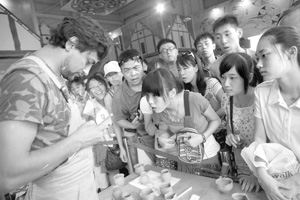Our art in China
Ukrainian pavilion among top ten at Shanghai Expo 2010
The Modern Art Gallery A-House took part in the exposition at the Ukrainian Pavilion at the international exhibition Shanghai EXPO 2010 in China, where it presented a project by the artist Mykola Zhuravel named “Pasika Apiary”. The exhibit opened on May 1 and will last until October 31 this year. During nearly four months of EXPO 2010, Ukraine has received constant attention from both the visitors of the art forum and the Chinese mass media.
Shanghai EXPO 2010 is the first international exhibit of this type where Ukraine represented its own National Pavilion. This might be due to the fact that our country was the first to sign an agreement with China on participation in the EXPO 2010. According to Serhii Budyrliak, consul of Ukraine in Shanghai, this step is highly appreciated in China: “The Chinese party thinks highly of the work of our National pavilion, the Chinese media speak a lot about Ukraine, and September this year is the time when an official visit of Viktor Yanukovych to China is scheduled. Our president has declared the development of bilateral Ukraine-China relations as one of Ukraine’s most important priorities in foreign policy.”
Of course, having our own National pavilion is a great achievement for our country, since international EXPOs are the third most watched event, after the World Soccer Championships and the Olympics. Shanghai EXPO 2010 has become the biggest exhibit in its 120-year-old history, with 190 countries participating and nearly one million visitors daily. According to experts, the exposition in Shanghai will remain the largest one in the next 100 years to come.
With an effective use of the huge amount of information concentrated at the EXPO, one can successfully exercise what is known as “soft influence.” It seems Ukrainians are good at this. Natalia ANDREIEVA, director, Gallery A-House, told The Day that, according to the assessments of the EXPO masterminds and the Chinese press, Ukraine’s National Pavilion made it to the top ten pavilions at this exhibit. Its opening was broadcast every 15 minutes during the first two days of the exhibition by the First National Channel of China, with its audience of 1.5 billion viewers.
“The masterminds evaluated the appropriateness of the implementation of the exhibit’s task rather than the outer parameters of the pavilions. Since ecology is the theme of this year’s EXPO, the task was to render the national mentality, one’s own vision of the ecology of space and society, rather than demonstrate one’s achievements in business,” Andreieva explains.
In recent decades, international EXPOs indeed tend to depart from the purely technological themes and pay more attention to problems of ecology and man’s interaction with nature. Accordingly, Ukraine’s National pavilion was also dedicated to the ecology of society, and to Petro Prokopovych who was the first to invent, in 1848, a frame technology which enabled an apiarist to extract honey without killing the bees. Thus Prokopovych proved that one could live without violence.
At the Shanghai exhibit, the Ukrainians presented two ecological sculptures and a video. The main emphasis was made on architect Ihor Svystun’s project “The City of 21st century. From Dream to Model.” The model represents a closed system with a population of 100,000.
The National pavilion of Ukraine has initiated several events in Shanghai during the time of its existence, in particular, the presentation of the project “The World with One’s Own Hands” and a children’s festival.
“The World with One’s Own Hands” by the embroideress Tetiana Protcheva is the creation of an embroidered map of the world which reflects the EXPO’s global scale and helps create a rapport among its participants. The Ukrainian pavilion also initiated a festival for Chinese children in the wake of the International Children’s Day. The participants not only got acquainted with the exposition at the pavilion, but also learned the arts of pottery and embroidery.
The National pavilion also houses Mykola Zhuravel’s international art project “Pasika Apiary” whose key idea (the ecology of society) immediately relates to the theme of the exhibit. Prior to Shanghai 2010, the project “Pasika Apiary” toured America and Switzerland. In Ukraine it was exhibited at the art gallery Lavra in Kyiv. The Day already wrote about Zhuravel’s project and his concept “Pasika Apiary” was shown to the Kyiv public (No. 144 of Aug. 18, 2009).
These projects enabled the Ukrainians to create an atmosphere which was especially prized by the Chinese guests. According to Andreieva, it was expected that the National pavilion would receive 15 thousand visitors daily, while they turned out to be much more numerous.






